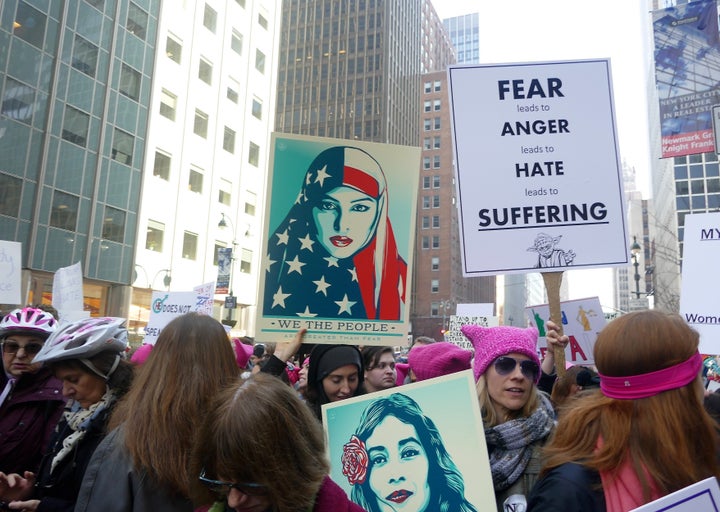
Honestly, I had not planned to attend the Toronto Women's March. I have an ethically difficult time justifying Canadian protests framed around American politics. So, I was not intending to march on Saturday -- that is, until I listened to the speech by Planned Parenthood president Cecile Richards in Washington that morning.
Richards' defiant commitment to keep her organization's doors open made tangible for me the reality in which Americans have now found themselves. And then I remembered how I felt on November 9th. I could never forgive myself for failing to do my utmost to prevent a moment like that in Canada.
It seems a lot of people had similar thoughts. On 21 January people participated in Women's Marches across 32 Canadian cities. Organizers estimate that 60 000 showed up in Toronto to march from Queen's Park to City Hall. There were creative signs and pussy hats. People brought their kids. Police were polite, but present. The crowd was energetic and defiant, yet in good spirits.
What made the Toronto march all the more interesting was the theme around which it coalesced: intersectional resistance. Marchers pointed to Leitch and O'Leary, yes, but also the need to mobilize, even and perhaps especially in a situation of normal politics, for equality and compassion.
Signs and speeches mentioned subjects from refugees to union rights, Black Lives Matter, the minimum wage, electoral reform, Idle No More, missing and murdered Indigenous women, social housing, the cost of childcare, climate change, public transit, and water rights -- all under the heading of intersectional feminism and solidarity.

Intersectionality means that different systems of discrimination are connected. Gender issues "intersect" with issues of class, sexuality, disability, and race. For instance, Indigenous women are much more likely than non-Indigenous women to be the victims of violent crime. Intersectional resistance, then, is about fighting inequality and oppression across identity lines.
The Women's March emphasis on intersectionality was especially important in the Toronto context, just months after the Pride Parade was interrupted by Black Lives Matter activists, who argued that the LGBTQ movement gave too little attention to race issues. Saturday's march was an important step toward mending these cleavages amongst Toronto's activist communities.
But questions have already been raised about whether the Women's Marches will become another Occupy Wall Street -- a moment of futile galvanization, rather than an historical watershed. Faced with the critique that the Occupy movement was simply too unfocused, many are beginning to wonder whether we are repeating past mistakes.
Even if the Women's Marches have scored well on symbolism and ability to attract a broad coalition, are the movement's goals sufficiently clear -- especially for the imported Canadian variant?
I think (hope) so. And here's why: an intersectional resistance movement, which is aimed at overcoming the competitive partitions between activist groups that undermine their collective power, is distributed but not unfocused.
"Equality, in all its forms, is the goal. Intersectional resistance and solidarity are the means."
An intersectional resistance movement begins from a general orientation of solidarity. But it is distributed in the sense that it accommodates groups simultaneously agitating for distinct, yet complementary, goals.
As trans activist Janet Mock, who spoke at the Women's March on Washington, said: "Our approach to freedom need not be identical, but it must be intersectional and inclusive. It must extend beyond ourselves. [...] I know with surpassing certainty that my liberation is directly linked to the undocumented trans Latina yearning for refuge, the disabled student seeking unequivocal access, the sex worker fighting to make her living safely." Intersectionality makes things more complicated, but that is not the same thing as being unfocused.
Equality, in all its forms, is the goal. Intersectional resistance and solidarity are the means. And although we can imagine different policy goals under this heading, there is content to the stance that equality means beginning with the truth of intersectionality: success requires dismantling all sources of oppression, not just one.
Black Lives Matter is about class as well as race. A Pride Parade cannot focus only on homophobia. A "Women's March" can never be just about women. Self-evident though the point may be, it requires that activists position themselves toward intersectionality not merely rhetorically, but in their strategic orientation as well. And that is a game-changer.
Follow HuffPost Canada Blogs on Facebook
Also on HuffPost: